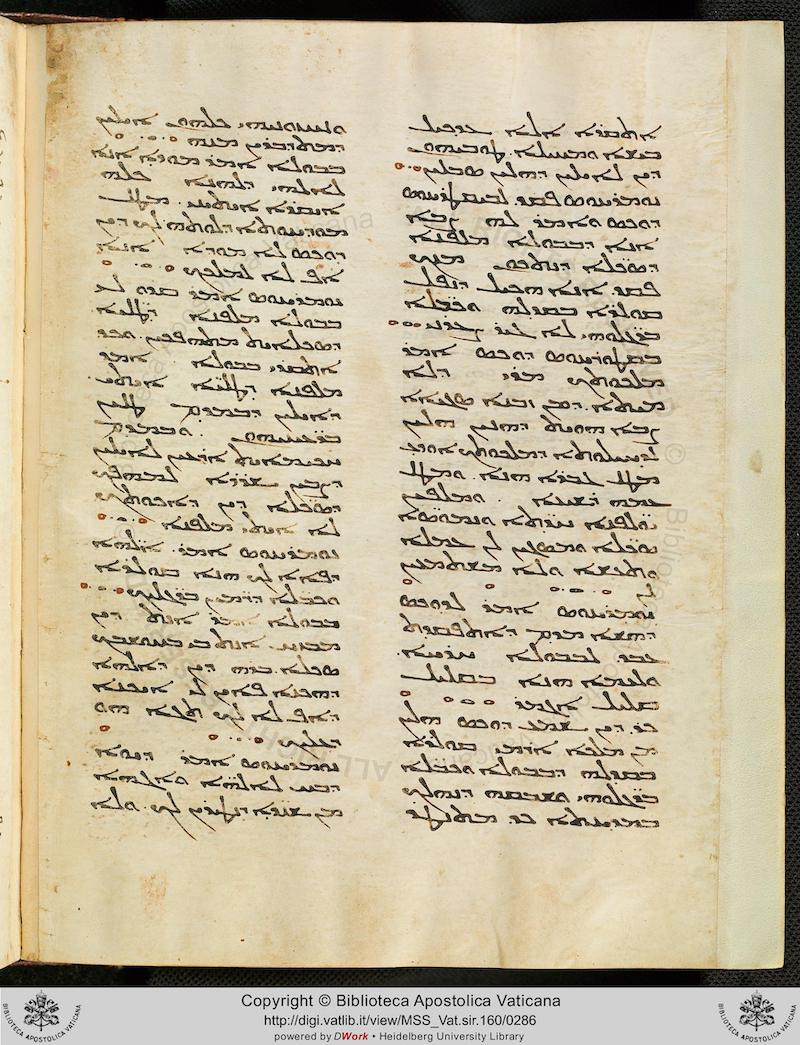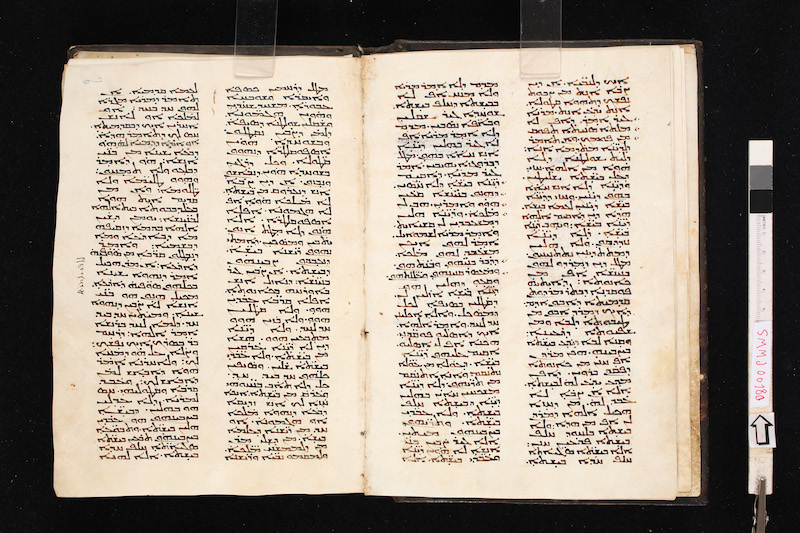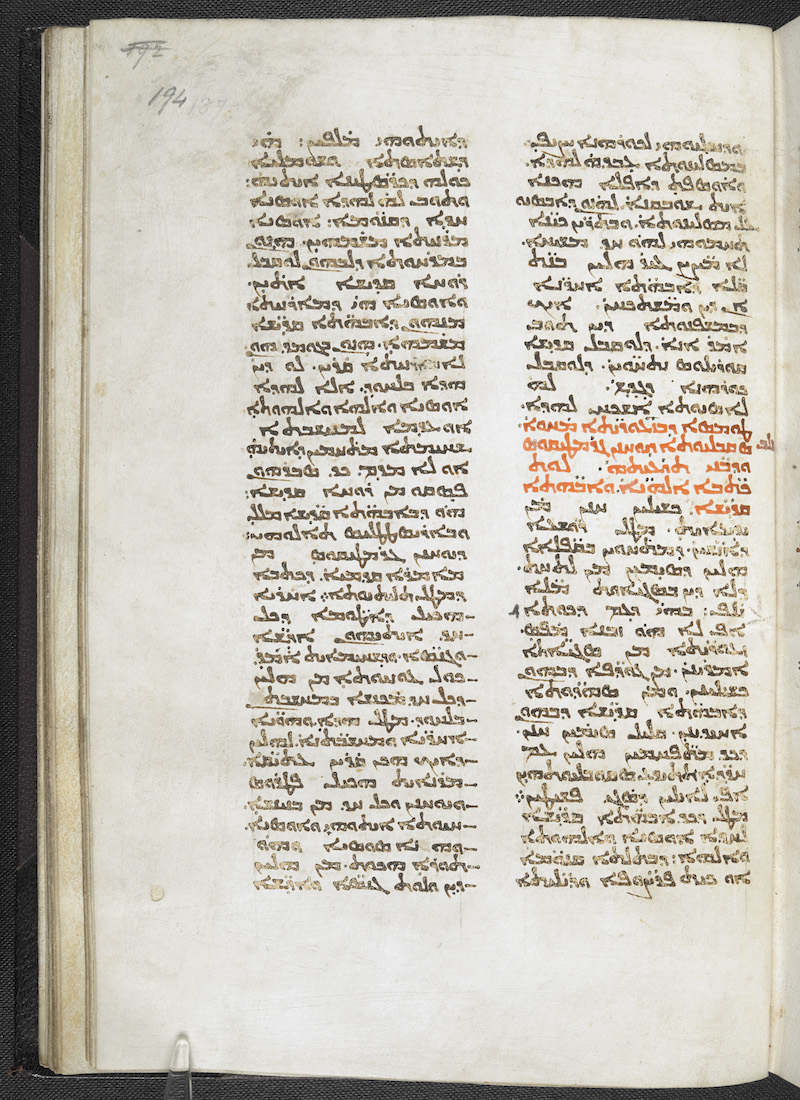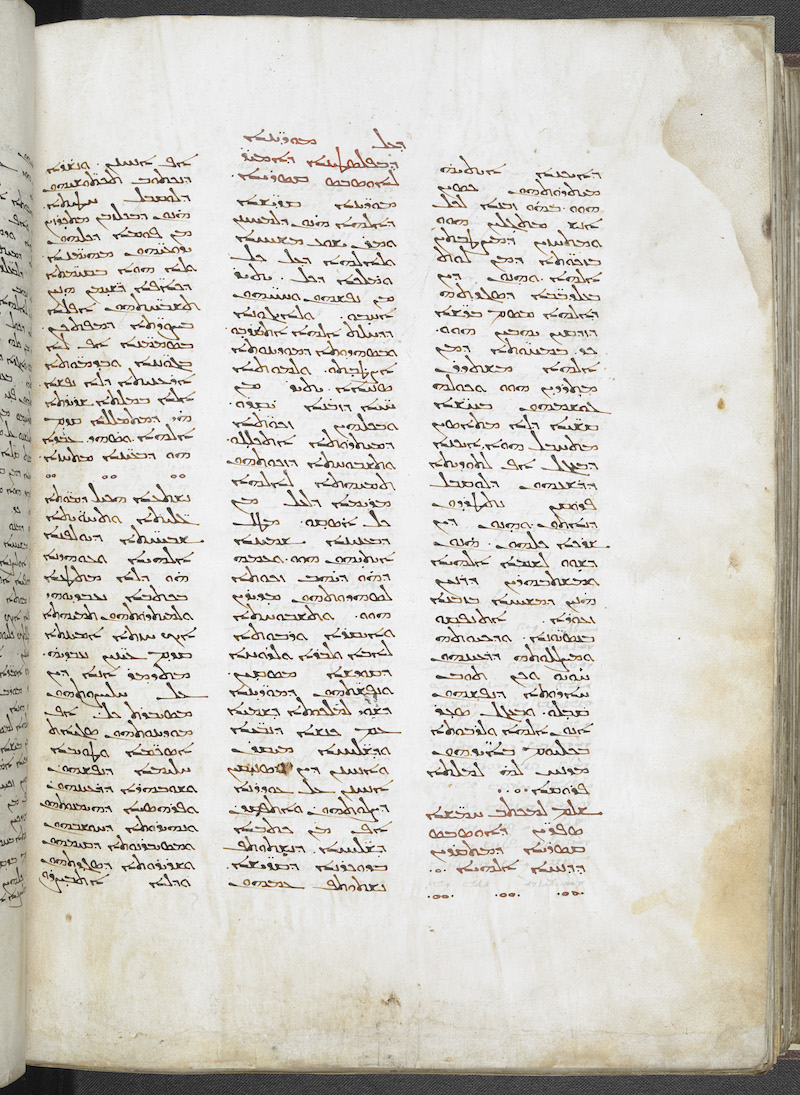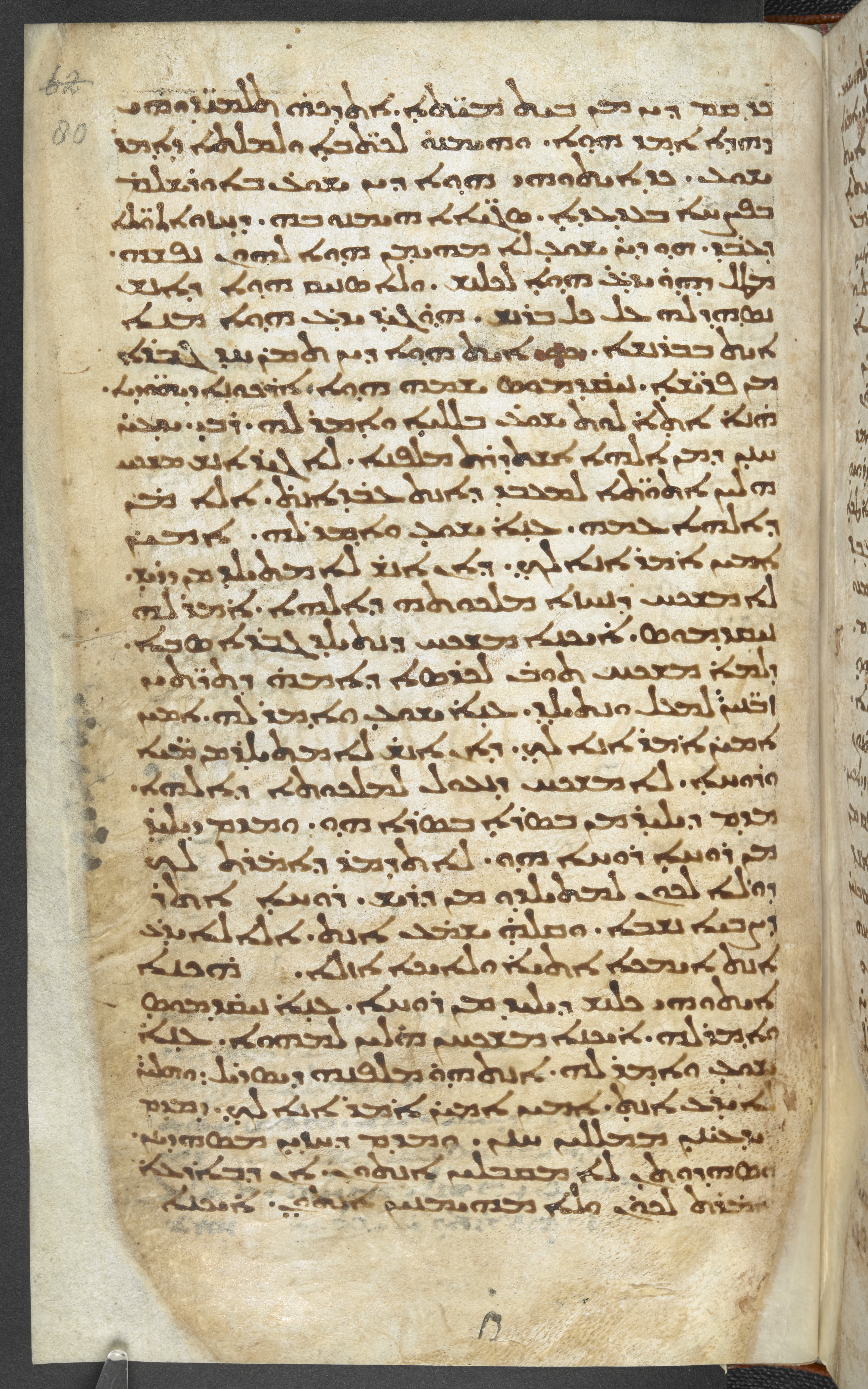
Estrangela, 7th century
-
Title
Gospels -
Text
John 2:22-3:12 -
Language(s)
Syriac -
Writing System
Syriac -
Script(s)
Estrangela -
Country
Great Britain -
City
London -
Repository
British Library -
Shelf Mark
Add. 14460, fol. 80r -
Century
7th century -
Year Range
599-600 -
Place Of Origin
Tel Dinawar in Bēt Nuhādrā -
Provenance
Colophon dated 911 AG, the tenth year of Šāhān-šāh Xosrow II (599/600 CE) -
Bibliography
William Wright, Catalogue of Syriac Manuscripts in the British Museum Acquired Since the Year 1838 (1870), p. 52-53.
104 leaves, on parchment. 1 column, 30-37 lines per page; support dimensions 19.5 x 12.2 cm
Acknowledgements: Described by Adam McCollum
Transcription
The lines have been numbered. The dots are included and placed as close as typographically possible to the way they are in the manuscript.
01 ܟܕ ܩܡ ܕܝܢ ܡܢ ܒܝܬ ܡܝ̈ܬܐ܉ ܐܬܕܟܪܘ ܬܠܡܝ̈ܕܘܗܝ
02 ܕܗܕܐ ܐܡ̣ܪ ܗܘ̣ܐ. ܘܗܝܡܢܘ̇ ܠܟܬ̈ܒܐ̣ ܘܠܡܠܬܐ ܕܐ̣ܡܪ
03 ܝܫܘܥ. ܟܕ ܐܝܬܘܗܝ ܗܘ̣ܐ ܕܝܢ ܝܫܘܥ̇ ܒܐܘܪܫܠܡ̇
04 ܒܦܨܚܐ ܒܥܕܥܕܐ܉ ܣܓ̈ܝܐܐ ܗܝܡܢܘ ܒܗ. ܕܚܙܘ ܐܬܘ̈ܬܐ
05 ܕܥܒ̇ܕ. ܗܘ̣ ܕܝܢ̇ ܝܫܘܥ̣ ܠܐ ܡܗܝܡ̣ܢ ܗܘ̣ܐ ܠܗܘܢ ܢܦܫܗ.
06 ܡܛܠ ܕܗ̣ܘ̇ ܝܕܲܥ̇ ܗܘ̣ܐ̣ ܠܟܠܢܫ. ܘܠܐ ܣܢܝܩ ܗܘ̣ܐ ܕܐܢܫ
07 ܢܣ̣ܗܕ ܠܗ ܥܠ ܟܠ ܒܪܢܫ. ܗ̣ܘ̇ ܓܝܪ̣ ܝܕ̇ܥ ܗܘ̣ܐ ܡܢܐ
08 ܐܝܬ ܒܒܪܢܫܐ܀ ܐܝܬ ܗܘ̣ܐ ܕܝܢ ܬܡܢ̇ ܚܕ ܓܒܪܐ
09 ܡܢ ܦܪ̈ܝܫܐ܉ ܢܝܩ̇ܕܡܘܣ ܫܡܗ ܗܘ̣ܐ. ܐܪܟܘܢܐ ܕܐܝܗ̈ܘܕܝܐ.
10 ܗ̇ܢܐ̇ ܐܬ̣ܐ̇ ܠܘܬ ܝܫܘܥ̇ ܒܠܠܝܐ̣ ܘܐ̣ܡܪ ܠܗ. ܪܒܝ܉ ܝܕܥܝܢ̇
11 ܚܢ̣ܢ ܕܡܢ ܐܠܗܐ ܐܫܬܕܪܬ ܡܠܦܢܐ. ܠܐ ܓܝܪ ܐܢܫ ܡܫܟܚ
12 ܗܠܝܢ ܐܬܘ̈ܬܐ ܠܡܥܒܕ ܕܐܢܬ ܥܒ̇ܕ ܐܢܬ܇ ܐܠܐ ܡ̇ܢ
13 ܕܐܠܗܐ ܥܡܗ. ܥܢ̣ܐ̇ ܝܫܘܥ̣ ܘܐܡ̣ܪ ܠܗ. ܐܡܝܢ̇
14 ܐܡܝܢ ܐ̇ܡܪ ܐܢܐ ܠܟ̣܉ ܕܐܢ ܐܢܫ̇ ܠܐ ܡܬܝܠܕ ܡܢ ܕܪܝܫ܉
15 ܠܐ ܡܫܟܚ ܕܢܚܙܐ ܡܠܟܘܬܗ ܕܐܠܗܐ. ܐ̇ܡܪ ܠܗ
16 ܢܝܩܕܡܘܣ. ܐ̇ܝܟܢܐ ܡܫܟܚ ܕܢܬܝܠܕ ܓܒܪܐ ܣܒܐ.
17 ܕܠܡܐ̇ ܡܫܟܚ ܬܘܒ̇ ܠܟܪܣܐ ܕܐܡܗ̇ ܕܬܪ̈ܬܝܢ
18 ܙܒ̈ܢܝܢ܃ ܠܡܥܠ ܘܢܬܝܠ̣ܕ. ܥܢ̣ܐ̇ ܝܫܘܥ̣ ܘܐ̣ܡܪ ܠܗ. ܐܡܝܢ
19 ܐܡܝܢ̇ ܐ̇ܡܪ ܐܢܐ ܠܟ̣܉ ܕܐܢ ܐܢܫ̇ ܠܐ ܡܬܝܠܕ̇ ܡܢ ܡ̈ܝܐ
20 ܘܪܘܚܐ̣. ܠܐ ܡܫܟܚ ܕܢ̣ܥܘܠ ܠܡܠܟܘܬܐ ܕܐܠܗܐ.
21 ܡܕܡ ܕܠܝܠܝܕ̇ ܡܢ ܒܣܪܐ̣ ܒܣܪܐ ܗ̱ܘ. ܘܡܕܡ ܕܝܠܝܕ̇
22 ܡܢ ܪܘܚܐ̣ ܪܘܚܐ ܗ̣ܘ. ܠܐ ܬܕܡܪ ܕܐܡ̇ܪܬ ܠܟ
23 ܕܘ̄ܠܐ ܠܟܘܢ ܠܡܬܝܠܕܘ ܡܢ ܕܪܝܫ. ܪܘܚܐ̣ ܐܬܪ
24 ܕܨܒܝܐ ܢܫܒܐ. ܘܩܠܗ̣̇ ܫܡ̇ܥ ܐܢܬ. ܐܠܐ ܠܐ ܝܕ̇ܐ
25 ܐܢܬ ܐܝܡܟܐ ܐܬܝܐ̇ ܘܠܐܝܟܐ ܐܙܠܐ. ܗ̇ܟܢܐ
26 ܐܝܬܘܗܝ ܟܠܢܫ ܕܝܠܝܕ ܡܢ ܪܘܚܐ. ܥܢ̣ܐ̇ ܢܝܩ̇ܕܡܘܣ̣
27 ܘܐ̣ܡܪ ܠܗ. ܐ̇ܝܟܢܐ ܡܫܟܚܢ ܗ̇ܠܝܢ ܠܡܗܘܐ. ܥܢ̣ܐ̇
28 ܝܫܘܥ̣ ܘܐܡ̣ܪ ܠܗ. ܐܢܬ ܗ̣ܘ̇ ܡܠܦܢܗ ܕܝܣܪܝܠ܈ ܘܗܠܝܢ܃
29 ܠܐ ܝܕ̇ܥ ܐܢܬ܉ ܐܡܝܢ ܐܡܝܢ̇ ܐ̇ܡܪ ܐܢܐ ܠܟ̣܉ ܕܡܕܡ
30 ܝܕܥܝ̇ܢ̣ܢ ܡܡܠܠܝܢ ܚܢܢ. ܘܡܕܡ ܕܚܙ̣ܝ̣ܢ ܡܣܗܕܝܢܢ.
31 ܘܣܗܕܘܬܢ̣ ܠܐ ܡܩܒܠܝܢ ܐܢܬܘܢ. ܐܢ ܕܒܐܪܥܐ̇
32 ܐܡ̇ܪܬ ܠܟܘ̇ܢ ܘܠܐ ܡܗܝܡܢܝܢ ܐܢܬܘܢ̣܉ ܐ̇ܝܟܢܐ
Paleographic Features
Comments on specific letter shapes
1. ālap: serif on right leg; left leg hangs below line
2. gāmal: ends well below line, but without the thick dot of some later examples
3. dālat/rēš: usually of the presumably typical, angled Estrangela form, but sometimes more round at top
4. hē: center post angled somewhat to the left
5. wāw: very round; open loop
6. kap: quite round
7. mim: open loop, or barely closed; final form with very thin tail
8. šin: horizontal line not too thick; top line not too round
9. tāw: loop open when unconnected on either side; lacking a proper loop at the bottom the vertical may only angle only slightly to the left
